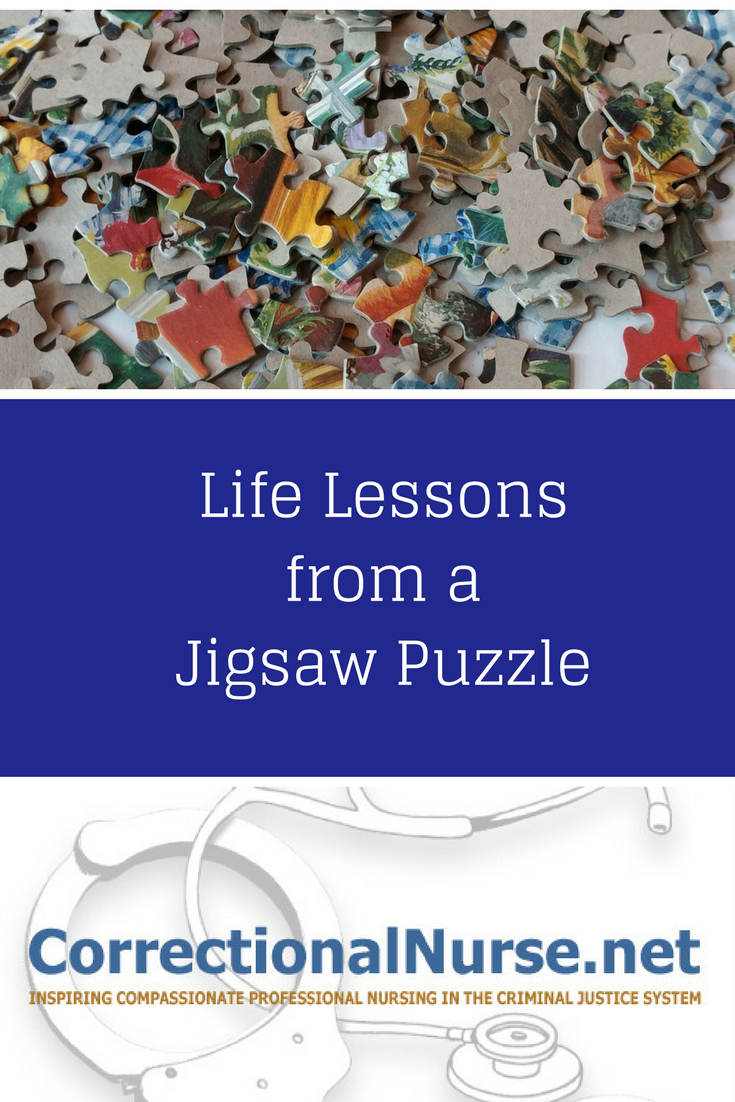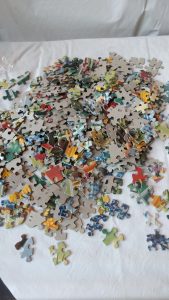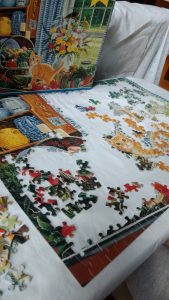 I recently spent a week with my Mom. When I visit we always pull out a jigsaw puzzle to set while we reminisce and chat about our extended family. As we moved through our usual ritual of sorting a pile of 500+ colorful oddly-shaped pieces of cardboard, I pondered how the many dilemmas of correctional nursing practice can seem like an impossible jigsaw puzzle. This really became an engaging activity as I tried for a list of life lessons from the puzzle process. Here’s my list.
I recently spent a week with my Mom. When I visit we always pull out a jigsaw puzzle to set while we reminisce and chat about our extended family. As we moved through our usual ritual of sorting a pile of 500+ colorful oddly-shaped pieces of cardboard, I pondered how the many dilemmas of correctional nursing practice can seem like an impossible jigsaw puzzle. This really became an engaging activity as I tried for a list of life lessons from the puzzle process. Here’s my list.
1. A problem to solve looks like an insurmountable mess at the start.
When you dump hundreds of puzzle pieces onto a table it doesn’t seem they will ever turn into that picture on the box top. While I have set dozens of puzzles, it still seems impossible that we will finish when we start. But, just as the Chinese proverb suggests – A journey of a thousand miles begins with one step. Some times all it takes is getting started.
Do you have a seemingly insurmountable task in your practice? Whether it be revising the medication administration process, preparing for a first-time accreditation, or studying for certification, don’t be overwhelmed by the magnitude of the problem at first. Instead, see lesson two below…
 2. Start with the edges.
2. Start with the edges.
I don’t know if it is standard puzzle process, but we always find the edge pieces and get them arranged first before tackling the rest of the puzzle. By fitting out the border, we are able to see the dimensions of the picture. That can mean a lot in getting momentum to move forward.
That impossible issue you are struggling with may need some evaluation as to dimensions. Can you see the big picture by getting perspective on the edges of the issue? That difficult conversation with a colleague or ethical challenge might need some ‘big picture’ thought on your part in order to see what your next steps must be.
3. Sort out the pieces first.
While looking for edge pieces to frame out the picture, we also start creating piles of like pieces for later work. Whether the kitten, china, or flower arrangement, many pieces identify their nature. Less distinct areas such as sky and background are hardest and left until last. Then it is all about dividing up the work on different parts of the puzzle picture.
That mountain of tasks on a large project might need to be sorted, as well. Grouping like items and tackling them together can increase efficiency and effectiveness. I am sometimes asked about how to write a book. It, too, can seem an impossible task. But, writing a book is about writing chapters. Chapters are made up of paragraphs and paragraphs of sentences. Writing a book ends up being about writing one sentence after another.
 4. Small wins lead to big wins.
4. Small wins lead to big wins.
In our recent puzzle-setting experience, as with many others, we celebrated completing the edge or the kitten in the foreground. Each small win meant we were closer to a big win – the completion of the puzzle.
Once you sort out and tackle those smaller projects in the midst of a big project, be sure to celebrate the small wins that lead to the big win. Don’t wait until the very end. Enjoy the journey as well as the goal.
5. Sometimes you have the pieces upside down.
This life lesson hit me hard this time around. Many times during the setting of this particular puzzle I was holding the piece upside down and could not get it to fit until I turned it around.
There are many times we are looking at an issue from a particular angle and can’t get it worked out. It may be that a new perspective is needed to see where it all fits together.
 Do you set jigsaw puzzles? What lessons can you add to my list? Share your thoughts in the comments section of this post.
Do you set jigsaw puzzles? What lessons can you add to my list? Share your thoughts in the comments section of this post.
Gayle Burrow says
I am glad your visit with your mother and this puzzle brought you to give us wisdom in our work. The end result is a pretty picture just as helping a patient through an illness is a pretty picture. Thanks for sharing Lorry.